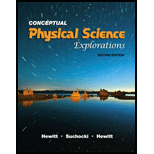
How much energy, in kilojoules, is released or absorbed from the reaction of 1 mole of nitrogen,
(a)
(b)
(c)
(d)
The correct option for the statement “How much energy, in kilojoules, is released or absorbed from the reaction of 1 mole of nitrogen,
Answer to Problem 9RAT
1 for bond energies” is option (c).
Explanation of Solution
The quantity of energy essential in any chemical reaction to dissociate a bond is termed as bond energy. The same amount of energy is released if the same bond is formed.
The reaction given can be written in the chemical equation as given below,
The amount of energy released or absorbed can be calculated as follows,
According to the given reaction,
There is one
There are three
Thus, the total energy absorbed to break the bonds in the reactant is
There are three
Thus, the net energy of the reaction can be given as,
Conclusion:
Therefore, the correct option is option (c).
Chapter 20 Solutions
Conceptual Physical Science Explorations
Additional Science Textbook Solutions
University Physics Volume 1
University Physics (14th Edition)
Essential University Physics: Volume 2 (3rd Edition)
Physics for Scientists and Engineers with Modern Physics
Physics for Scientists and Engineers: A Strategic Approach, Vol. 1 (Chs 1-21) (4th Edition)
College Physics: A Strategic Approach (3rd Edition)
 College PhysicsPhysicsISBN:9781305952300Author:Raymond A. Serway, Chris VuillePublisher:Cengage Learning
College PhysicsPhysicsISBN:9781305952300Author:Raymond A. Serway, Chris VuillePublisher:Cengage Learning University Physics (14th Edition)PhysicsISBN:9780133969290Author:Hugh D. Young, Roger A. FreedmanPublisher:PEARSON
University Physics (14th Edition)PhysicsISBN:9780133969290Author:Hugh D. Young, Roger A. FreedmanPublisher:PEARSON Introduction To Quantum MechanicsPhysicsISBN:9781107189638Author:Griffiths, David J., Schroeter, Darrell F.Publisher:Cambridge University Press
Introduction To Quantum MechanicsPhysicsISBN:9781107189638Author:Griffiths, David J., Schroeter, Darrell F.Publisher:Cambridge University Press Physics for Scientists and EngineersPhysicsISBN:9781337553278Author:Raymond A. Serway, John W. JewettPublisher:Cengage Learning
Physics for Scientists and EngineersPhysicsISBN:9781337553278Author:Raymond A. Serway, John W. JewettPublisher:Cengage Learning Lecture- Tutorials for Introductory AstronomyPhysicsISBN:9780321820464Author:Edward E. Prather, Tim P. Slater, Jeff P. Adams, Gina BrissendenPublisher:Addison-Wesley
Lecture- Tutorials for Introductory AstronomyPhysicsISBN:9780321820464Author:Edward E. Prather, Tim P. Slater, Jeff P. Adams, Gina BrissendenPublisher:Addison-Wesley College Physics: A Strategic Approach (4th Editio...PhysicsISBN:9780134609034Author:Randall D. Knight (Professor Emeritus), Brian Jones, Stuart FieldPublisher:PEARSON
College Physics: A Strategic Approach (4th Editio...PhysicsISBN:9780134609034Author:Randall D. Knight (Professor Emeritus), Brian Jones, Stuart FieldPublisher:PEARSON





